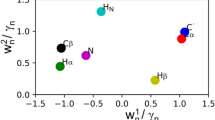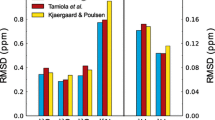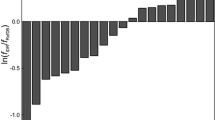Abstract
Protein chemical shifts have long been used by NMR spectroscopists to assist with secondary structure assignment and to provide useful distance and torsion angle constraint data for structure determination. One of the most widely used methods for secondary structure identification is called the Chemical Shift Index (CSI). The CSI method uses a simple digital chemical shift filter to locate secondary structures along the protein chain using backbone 13C and 1H chemical shifts. While the CSI method is simple to use and easy to implement, it is only about 75–80 % accurate. Here we describe a significantly improved version of the CSI (2.0) that uses machine-learning techniques to combine all six backbone chemical shifts (13Cα, 13Cβ, 13C, 15N, 1HN, 1Hα) with sequence-derived features to perform far more accurate secondary structure identification. Our tests indicate that CSI 2.0 achieved an average identification accuracy (Q3) of 90.56 % for a training set of 181 proteins in a repeated tenfold cross-validation and 89.35 % for a test set of 59 proteins. This represents a significant improvement over other state-of-the-art chemical shift-based methods. In particular, the level of performance of CSI 2.0 is equal to that of standard methods, such as DSSP and STRIDE, used to identify secondary structures via 3D coordinate data. This suggests that CSI 2.0 could be used both in providing accurate NMR constraint data in the early stages of protein structure determination as well as in defining secondary structure locations in the final protein model(s). A CSI 2.0 web server (http://csi.wishartlab.com) is available for submitting the input queries for secondary structure identification.




Similar content being viewed by others
References
Adamczak R, Porollo A, Meller J (2005) Combining prediction of secondary structure and solvent accessibility in proteins. Proteins Struct Funct Bioinform 59(3):467–475
Adams PD, Baker D, Brunger AT, Das R, DiMaio F, Read RJ, Richardson DC, Richardson JS, Terwilliger TC (2013) Advances, interactions, and future developments in the CNS, Phenix and Rosetta structural biology software systems. Annu Rev Biophys 43:265–287
Alexander PA, He Y, Chen Y, Orban J, Bryan PN (2009) A minimal sequence code for switching protein structure and function. Proc Natl Acad Sci 106(50):21149–21154
Altschul SF, Madden TL, Schäffer AA, Zhang J, Zhang Z, Miller W, Lipman DJ (1997) Gapped BLAST and PSI-BLAST: a new generation of protein database search programs. Nucleic Acids Res 25(17):3389–3402
Andrec M, Snyder DA, Zhou Z, Young J, Montelione GT, Levy RM (2007) A large data set comparison of protein structures determined by crystallography and NMR: statistical test for structural differences and the effect of crystal packing. Proteins Struct Funct Bioinform 69(3):449–465
Berjanskii MV, Wishart DS (2005) A simple method to predict protein flexibility using secondary chemical shifts. J Am Chem Soc 127(43):14970–14971
Berjanskii M, Tang P, Liang J, Cruz JA, Zhou J, Zhou Y, Bassett E, MacDonell C, Lu P, Wishart DS (2009) GeNMR: a web server for rapid NMR-based protein structure determination. Nucleic Acids Res 37((Web server issue)):W670–W677
Berman HM, Westbrook J, Feng Z, Gilliland G, Bhat TN, Weissig H, Shindyalov IN, Bourne PE (2000) The protein data bank. Nucleic Acids Res 28(1):235–242
Camilloni C, De Simone A, Vranken WF, Vendruscolo M (2012) Determination of secondary structure populations in disordered states of proteins using nuclear magnetic resonance chemical shifts. Biochemistry 51(11):2224–2231
Cheung MS, Maguire ML, Stevens TJ, Broadhurst RW (2010) DANGLE: a Bayesian inferential method for predicting protein backbone dihedral angles and secondary structure. J Magn Reson 202(2):223–233
Cole C, Barber JD, Barton GJ (2008) The Jpred 3 secondary structure prediction server. Nucleic Acids Res 36(suppl 2):W197–W201
Development Core Team R (2009) R: a language and environment for statistical computing. R Foundation for Statistical Computing, Vienna
Durrett R (2010) Probability: theory and examples, vol 3. Cambridge University Press, London
Eghbalnia HR, Wang L, Bahrami A, Assadi A, Markley JL (2005) Protein energetic conformational analysis from NMR chemical shifts (PECAN) and its use in determining secondary structural elements. J Biomol NMR 32(1):71–81
Eyrich VA, Marti-Renom MA, Przybylski D, Madhusudhan MS, Fiser A, Pazos F, Valencia A, Sali A, Rost B (2001) EVA: Continuous automatic evaluation of protein structure prediction servers. Bioinformatics 17:1242–1243
Fesinmeyer RM, Hudson FM, Olsen KA, White GW, Euser A, Andersen NH (2005) Chemical shifts provide fold populations and register of β-hairpins and β-sheets. J Biomol NMR 33(4):213–231
Frishman D, Argos P (1995) Knowledge‐based protein secondary structure assignment. Proteins Struct Funct Bioinform 23(4):566–579
Han B, Liu Y, Ginzinger SW, Wishart DS (2011) SHIFTX2: significantly improved protein chemical shift prediction. J Biomol NMR 50(1):43–57
He B, Wang K, Liu Y, Xue B, Uversky VN, Dunker AK (2009) Predicting intrinsic disorder in proteins: an overview. Cell Res 19(8):929–949
Hung LH, Samudrala R (2003) Accurate and automated classification of protein secondary structure with PsiCSI. Protein Sci 12(2):288–295
Jones DT (1999) Protein secondary structure prediction based on position-specific scoring matrices. J Mol Biol 292(2):195–202
Jones DT, Tress M, Bryson K, Hadley C (1999) Successful recognition of protein folds using threading methods biased by sequence similarity and predicted secondary structure. Proteins Suppl 3:104–111
Kabsch W, Sander C (1983) Dictionary of protein secondary structure: pattern recognition of hydrogen-bonded and geometrical features. Biopolymers 22(12):2577–2637
Karatzoglou A, Smola A, Hornik K, Zeileis A (2004) kernlab-an S4 package for kernel methods in R. J Stat Softw 11:1–20
Kuhn M (2008) Building predictive models in R using the caret package. J Stat Softw 28(5):1–26
Labudde D, Leitner D, Krüger M, Oschkinat H (2003) Prediction algorithm for amino acid types with their secondary structure in proteins (PLATON) using chemical shifts. J Biomol NMR 25(1):41–53
Levitt M (1978) Conformational preferences for globular proteins. J Am Chem Soc 17(20):4277–4284
Mielke SP, Krishnan VV (2004) An evaluation of chemical shift index-based secondary structure determination in proteins: influence of random coil chemical shifts. J Biomol NMR 30(2):143–153
Mielke SP, Krishnan VV (2009) Characterization of protein secondary structure from NMR chemical shifts. Prog Nucl Magn Reson Spectrosc 54(3–4):141–165
Momen-Roknabadi A, Sadeghi M, Pezeshk H, Marashi SA (2008) Impact of residue accessible surface area on the prediction of protein secondary structures. BMC Bioinform 9(1):357
Montgomerie S, Sundraraj S, Gallin WJ, Wishart DS (2006) Improving the accuracy of protein secondary structure prediction using structural alignment. BMC Bioinform 7:301
Ratnaparkhi GS, Ramachandran S, Udgaonkar JB, Varadarajan R (1998) Discrepancies between the NMR and X-ray structures of uncomplexed barstar: analysis suggests that packing densities of protein structures determined by NMR are unreliable. Biochemistry 37(19):6958–6966
Rost B, Sander C, Schneider R (1994) Redefining the goals of protein secondary structure prediction. J Mol Biol 235:13–26
Schwarzinger S, Kroon GJ, Foss TR, Chung J, Wright PE, Dyson HJ (2001) Sequence-dependent correction of random coil NMR chemical shifts. J Am Chem Soc 123(13):2970–2978
Shen Y, Bax A (2012) Identification of helix capping and β-turn motifs from NMR chemical shifts. J Biomol NMR 52(3):211–232
Shen Y, Bax A (2013) Protein backbone and sidechain torsion angles predicted from NMR chemical shifts using artificial neural networks. J Biomol NMR 56(3):227–241
Shen Y, Delaglio F, Cornilescu G, Bax A (2009a) TALOS+: a hybrid method for predicting protein backbone torsion angles from NMR chemical shifts. J Biomol NMR 44(4):213–223
Shen Y, Vernon R, Baker D, Bax A (2009b) De novo protein structure generation from incomplete chemical shift assignments. J Biomol NMR 43(2):63–78
Shen Y, Bryan PN, He Y, Orban J, Baker D, Bax A (2010) De novo structure generation using chemical shifts for proteins with high-sequence identity but different folds. Protein Sci 19(2):349–356
Sievers F, Wilm A, Dineen D, Gibson TJ, Karplus K, Li W et al (2011) Fast, scalable generation of high-quality protein multiple sequence alignments using Clustal Omega. Mol Syst Biol 7(1):539
Soding J, Remmert M (2011) Protein sequence comparison and fold recognition: progress and good practice benchmarking. Curr Opin Struct Biol 21(3):404–411
Soding J, Biegert A, Lupas AN (2005) The HHpred interactive server for protein homology detection and structure prediction. Nucleic Acids Res 33((Web server issue)):W244–W248
Tyagi M, Bornot A, Offmann B, de Brevern AG (2009) Analysis of loop boundaries using different local structure assignment methods. Prot Sci 18(9):1869–1881
Ulrich EL, Akutsu H, Doreleijers JF, Harano Y, Ioannidis YE, Lin J et al (2008) BioMagResBank. Nucleic Acids Res 36(Suppl 1):D402–D408
UniProt Consortium (2010) The universal protein resource (UniProt) in 2010. Nucleic Acids Res 38(Suppl 1):D142–D148
Valdar WSJ (2002) Scoring residue conservation. Proteins Struct Funct Bioinform 48(2):227–241
Wang G, Dunbrack RLJ (2003) PISCES: a protein culling server. Bioinformatics 19(12):1589–1591
Wang Y, Jardetzky O (2002a) Probability-based protein secondary structure identification using combined NMR chemical-shift data. Protein Sci 11(4):852–861
Wang Y, Jardetzky O (2002b) Investigation of the neighboring residue effects on protein chemical shifts. J Am Chem Soc 124(47):14075–14084
Wang CC, Chen JH, Lai WC, Chuang WJ (2007a) 2DCSi: identification of protein secondary structure and redox state using 2D cluster analysis of NMR chemical shifts. J Biomol NMR 38(1):57–63
Wang L, Eghbalnia HR, Markley JL (2007b) Nearest-neighbor effects on backbone alpha and beta carbon chemical shifts in proteins. J Biomol NMR 39(3):247–257
Willard L, Ranjan A, Zhang H, Monzavi H, Boyko RF, Sykes BD, Wishart DS (2003) VADAR: a web server for quantitative evaluation of protein structure quality. Nucleic Acids Res 31(13):3316–3319
Wishart DS (2011) Interpreting protein chemical shift data. Prog Nucl Magn Reson Spectrosc 58(1):62–87
Wishart DS, Case DA (2002) Use of chemical shifts in macromolecular structure determination. Methods Enzymol 338:3–34
Wishart DS, Nip AM (1998) Protein chemical shift analysis: a practical guide. Biochm Cell Biol 76(2–3):153–163
Wishart DS, Sykes BD (1994a) Chemical shifts as a tool for structure determination. Methods Enzymol 239:363–392
Wishart DS, Sykes BD (1994b) The 13C chemical shift index: a simple method for the identification of protein secondary structure using 13C chemical shift data. J Biomol NMR 4(2):171–180
Wishart DS, Sykes BD, Richards FM (1992) The chemical shift index: a fast and simple method for the assignment of protein secondary structure through NMR spectroscopy. Biochemistry 31(6):1647–1651
Wishart DS, Arndt D, Berjanskii M, Tang P, Zhou J, Lin G (2008) CS23D: a web server for rapid protein structure generation using NMR chemical shifts and sequence data. Nucleic Acids Res 36((Web server issue)):W496–W502
Wuthrich K (1986) NMR of proteins and nucleic acids. Wiley, New York
Wuthrich K (1990) Protein structure determination in solution by NMR spectroscopy. J Bio Chem 265(36):22059–22062
Zemla A, Venclovas C, Fidelis K, Rost B (1999) A modified definition of SOV, a segment-based measure for protein secondary structure prediction assessment. Proteins 34:220–223
Zhang H, Neal S, Wishat DS (2003) RefDB: a database of uniformly referenced protein chemical shifts. J Biomol NMR 25:173–195
Zhang W, Dunker AK, Zhou Y (2008) Assessing secondary structure assignment of protein structures by using pairwise sequence‐alignment benchmarks. Proteins Struct Funct Bioinform 71(1):61–67
Acknowledgments
The authors would like to thank Yongjie Liang for his help in preparing the CSI 2.0 web server. Financial support from the Natural Sciences and Engineering Research Council (NSERC), the Alberta Prion Research Institute (APRI) and PrioNet is gratefully acknowledged.
Author information
Authors and Affiliations
Corresponding author
Rights and permissions
About this article
Cite this article
Hafsa, N.E., Wishart, D.S. CSI 2.0: a significantly improved version of the Chemical Shift Index. J Biomol NMR 60, 131–146 (2014). https://doi.org/10.1007/s10858-014-9863-x
Received:
Accepted:
Published:
Issue Date:
DOI: https://doi.org/10.1007/s10858-014-9863-x




